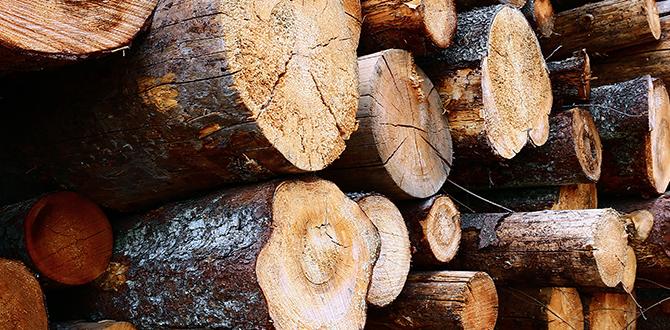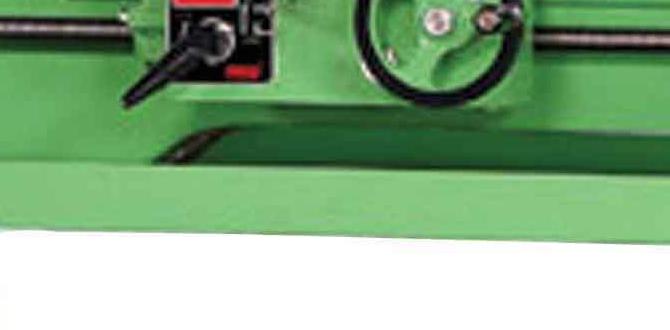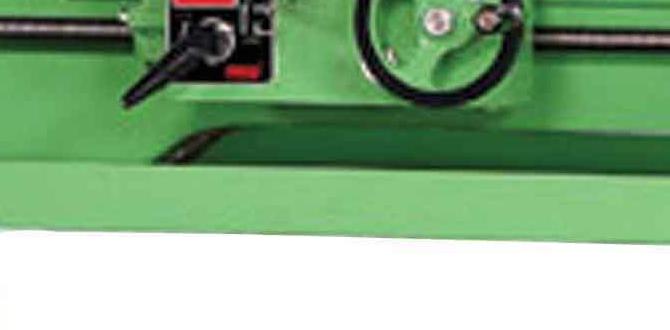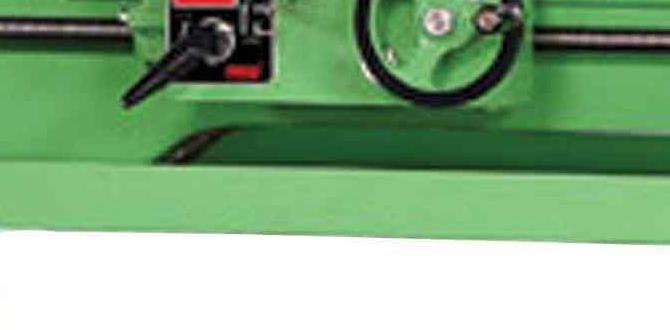Wood lathe vibration can be frustrating, but this guide provides proven solutions for a smoother, safer turning experience. We’ll cover common causes and simple fixes to get your lathe running true, making your woodworking projects a joy again.
Feeling that rumble and shake from your wood lathe? It’s a common frustration for woodturners, especially when you’re just starting out. That unwanted vibration doesn’t just feel bad; it can ruin your workpiece, make detailed cuts impossible, and even be a safety hazard. But don’t worry! As Daniel Bates from Lathe Hub, I’ve helped countless beginners tackle this exact problem. We’ll break down the causes of wood lathe vibration step-by-step, making it easy to understand and fix so you can get back to turning smoothly and safely.
Why Does My Wood Lathe Vibrate? The Core Issues
Wood lathe vibration is almost always down to one or a combination of a few key areas. Think of your lathe as a symphony orchestra – if one instrument is out of tune or playing too loud, it throws off the whole performance. Your lathe works the same way. When something isn’t balanced, secure, or running true, you get that annoying shake. The good news is that most of these issues have straightforward solutions that don’t require a machine shop to fix.
Here are the most common culprits:
Unbalanced Workpiece: This is by far the most frequent cause.
Loose Mounting/Support: How the wood attaches to the lathe matters.
Lathe Itself: Sometimes the machine needs a little attention.
Tooling Issues: Your chisels and gouges play a role.
Let’s dive into each of these and see how to get your lathe purring like a kitten.
Unbalanced Workpiece: The Main Suspect
When you first mount a piece of wood on your lathe, it’s rarely perfectly round. This is especially true for freshly cut logs or irregularly shaped blanks. As the lathe spins, that uneven mass trying to go in a circle creates centrifugal force. The heavier parts of the wood are thrown outwards more, causing a wobble. The faster the lathe spins, the more pronounced this effect becomes.
Common Causes of Workpiece Imbalance:
Irregularly Shaped Blanks: A log that’s not round to begin with is a prime candidate.
Uneven Moisture Content: If one side of your wood is drier than the other, it can lead to imbalance as it spins.
Improperly Mounted Blanks: The way you center and secure the wood is crucial.
Step-by-Step Solutions for Workpiece Imbalance:
-
Rough Shaping First
Before you get to fine-tuning, use your roughing gouge to shape the blank into a rough cylinder. This initial shaping helps distribute the mass more evenly. Work at a slower speed for this initial roughing stage.
-
Center Your Wood Properly
Whether you’re using a faceplate, screw chuck, or spur drive, ensure the center of the wood is perfectly aligned with the lathe’s headstock and tailstock centers. A slightly off-center mount will guarantee vibration.
-
Consider a Drive Center and Live Center Combination
For spindle turning (turning between centers), a sharp spur drive center in the headstock and a live tailstock center are essential. The spur drives the wood, and the live center simply supports it, allowing it to rotate freely without friction. Ensure both are sharp and properly seated in the wood. For faceplate work, a sturdy faceplate secured with appropriate screws is key.
-
Use a Live Center for Support
When turning long, thin pieces (spindle turning), the tailstock must support the outboard end of the wood. Use a live center here; it spins with the wood, reducing friction and allowing for smoother rotation.
-
Reduce Speed for Roughing and Large Blanks
Always start turning a new blank at a lower speed. As you remove mass and the wood becomes more round, you can gradually increase the speed. For large or very irregularly shaped pieces, keeping the speed lower is a good safety and vibration-reducing practice. A good rule of thumb is that the faster the lathe spins, the more sensitive it is to imbalance.
-
Check Moisture Content
If you suspect uneven drying is causing vibration, you might need to let the wood acclimate further or consider using a wood stabilizer if it’s for a long-term project. For immediate turning, you might have to accept some vibration or adjust your expectations for finish quality.
Loose Mounting and Support: The Hidden Agitators
Even with a nearly balanced piece of wood, if it’s not securely attached to the lathe, you’ll get vibration. Think about it: the lathe spinning is the engine, and the wood is the wheel. If the wheel isn’t firmly attached, it’s going to shake.
Common Causes of Loose Mounting:
Screws backing out of a faceplate or chuck.
Woodworking screws not seating deeply enough into the wood.
A chuck or faceplate that isn’t tightened properly on the headstock spindle.
The tailstock Quill not being locked down firmly.
Step-by-Step Solutions for Secure Mounting:
-
Tighten Your Faceplate and Chucks
Ensure your faceplate or chuck is securely threaded onto the headstock spindle. If you’re using a screw-on chuck, make sure it’s snug against the spindle shoulder. For threaded spindles, a chuck keyed into the threads will generally hold firm. If you have a screw-in faceplate, use a faceplate wrench or a stout wooden mallet to tap it securely into place.
-
Use Appropriate Screws for Faceplate Work
When attaching a faceplate to a blank, use screws that are long enough to bite into solid wood but not so long that they protrude through the other side. Ensure you’re using wood screws intended for this purpose and that they are driven straight and securely. It’s often best to pre-drill pilot holes slightly smaller than the screw shank.
-
Check Tailstock Lock
For any turning between centers, the tailstock needs to be firmly locked in position. The tailstock quill itself should also be extended just enough to support the wood and then locked. If the quill or the entire tailstock can move laterally, it will introduce significant vibration.
-
Use a Sturdy Screw Chuck Setup
If you’re using a screw chuck, ensure the screw portion is firmly seated in the headstock spindle adapter and the wood blank is drilled with an appropriate pilot hole before engaging it. The wood should be snug against the shoulder of the screw chuck.
-
Re-tighten as Needed
Wood can compress slightly as you turn, especially softwoods. Periodically check the tightness of your mounting hardware, particularly after roughing.
Lathe Itself: The Foundation of Smoothness
Sometimes, the vibration isn’t coming from the wood itself but from the lathe’s structure or its moving parts. These issues are less common on quality machines but can occur with older, well-used, or poorly maintained lathes.
Common Lathe-Related Issues:
Loose Headstock or Tailstock: The main structural components aren’t rigid.
Bent or Damaged Spindle/Arbor: The part that holds your chuck or faceplate is compromised.
Motor or Belt Problems: The power source is causing imbalances.
Unstable Base or Stand: The entire machine is rocking.
Step-by-Step Solutions for Lathe Issues:
-
Check for Loose Bolts and Fasteners
Go over your lathe and tighten any accessible bolts and nuts. This includes the bolts that attach the headstock to the bed, the tailstock to the bed, and the bed to the stand. A solid, rigid structure is key to absorbing shocks. Many beginner lathes are mounted on lighter stands; ensuring these are robust and firmly assembled is vital.
-
Inspect the Headstock Spindle and Tool Rest Banjo
Ensure the headstock spindle is running true. If you have a separate outboard turning attachment, make sure it’s also secured properly and that the spindle for that is not bent. The tool rest banjo (the sliding part that holds the tool rest) should lock firmly in place without any wiggle.
-
Examine Belts and Pulleys
Check the drive belt for wear or damage. A torn or uneven belt can cause pulsing. Also, ensure the pulleys on the motor and the headstock spindle are clean, undamaged, and that the belt is tensioned correctly – not too tight, not too loose. If your lathe has a stepped pulley system, ensure the pulleys are aligned.
-
Use a Level
Place a spirit level on the lathe bed to ensure it’s perfectly level. If the lathe is not level, or if the bed is warped, the tool rest may not be parallel to the spindle axis, leading to catches and vibration. You may need to shim the base of the lathe to achieve perfect levelness.
-
Consider Weighting the Stand
For lighter stands, especially those made of sheet metal, adding weight can significantly dampen vibrations. Placing sandbags, bags of cement, or even sturdy wooden blocks on the stand’s shelves can help. Ensure these added weights are secure and won’t shift.
-
External Resources for Lathe Maintenance
For specific models, manufacturer manuals are invaluable. Reputable woodworking forums and communities often have experienced users who can offer advice. For structural integrity, referencing general machine tool setup guides can be helpful. For example, understanding proper machine leveling is crucial for any precision equipment. You can find general guidance on machine setup and leveling on resources like NJ Dept. of Education’s Machine Shop resources or similar engineering education sites.
Tooling Issues: The Cutting Edge of the Problem
The tools you use to shape the wood also play a direct role in vibration. If your chisels, gouges, or scrapers are dull, chipped, or held at an incorrect angle, they’ll fight against the wood and the lathe, causing chatter and vibration.
Common Tooling Problems:
Dull Cutting Edges: This is the most common tooling issue.
Incorrect Tool Grinding: Wrong angles or a poorly formed bevel.
Improper Tool Rest Placement: The rest is too high, too low, or too far from the wood.
Using the Wrong Tool for the Job: Trying to scrape a large bowl with a detail spindle gouge, for instance.
Step-by-Step Solutions for Tooling Problems:
-
Keep Your Tools Sharp!
This cannot be stressed enough. A sharp woodturning tool cuts cleanly, requiring less force and producing less vibration. Dull tools tear at the wood, catch, and dig in, all of which contribute to chatter. Invest in a good sharpening system (stones, grinder with jigs) and learn to use it effectively.
-
Ensure Correct Grinding Angles
Different woodturning tools (spindle gouges, bowl gouges, scrapers) have specific bevel angles recommended for their use. Using the wrong angle can lead to poor cutting action. If you’re unsure, research the recommended angles for your specific tools. A common starting point for bowl gouges is around 40-50 degrees.
-
Proper Tool Rest Setup
The tool rest should be positioned close to the wood but not so close that it interferes with rotation. Generally, it should be set just barely away from the wood. For cutting tools like gouges, the rest should be slightly below the center line of the workpiece for spindle turning, and at or slightly below center for bowl turning. For scrapers, the rest is often set at the center line. Experimentation is key here, but always ensure the rest is securely locked.
-
Use the Right Tool
Turners use different tools for different tasks. A large bowl needs different considerations than a small spindle. Using a roughing gouge for initial shaping, a spindle or bowl gouge for hollowing and curves, and scrapers for final smoothing (though modern gouge techniques often minimize scraper use) will lead to more efficient and vibration-free turning.
-
Hollow Grinds vs. Flat Grinds
Most woodturning gouges are supplied with a hollow grind. This means the cutting edge is formed by two bevels that meet at a point. This creates a sharp cutting edge that cuts cleanly. If your grind is damaged or improperly formed, it will affect performance and potentially cause vibration.
-
Tool Safety and Grip
Maintain a firm but relaxed grip on your tools. If you’re death-gripping, you’re transferring tension into the cutting action, which can lead to chatter. Let the sharp tool do the work.
Troubleshooting Table: Vibration Symptoms and Likely Causes
Sometimes, you can identify the cause of vibration by the way it feels or sounds. This table can help you narrow down the possibilities.
| Symptom | Most Likely Causes | Potential Solutions |
|---|---|---|
| Heavy, consistent thumping or pounding, especially at higher speeds. | Significantly unbalanced workpiece (e.g., very irregular log, off-center mounting). | Rough shape blank into a cylinder, ensure perfect centering, reduce speed. |
| A high-pitched chatter or buzzing. | Dull tools, improper tool rest height, aggressive cuts, workpiece not securely held. | Sharpen tools, adjust tool rest, take lighter cuts, check mounting tightness. |
| Vibration felt mainly in the headstock or tailstock. | Loose headstock/tailstock mounting bolts, tailstock quill not locked, bent spindle. | Tighten all structural bolts, lock tailstock quill, inspect spindle for damage. |
| Vibration increases suddenly during a cut. | Tool catching or digging in (dull tool, wrong angle, aggressive cut), workpiece shifting. | Check tool sharpness and angle, lighten cut, ensure wood is firmly held. |
| Overall “loose” feeling or rocking of the entire lathe. | Unstable base/stand, lathe not level, loose structural components. | Add weight to stand, level the lathe, tighten all machine bolts. |
Advanced Balancing Techniques
For the most stubborn cases, or when working with very large, unbalanced pieces (like punky logs or irregularly shaped blanks), you might need to employ more advanced balancing techniques.
Balancing with Temporary Weights:
While not common for beginners, if you’re turning a very large, out-of-round piece and roughed it as much as possible, you can sometimes use temporary weights. This involves drilling small holes into the side of the spinning workpiece (carefully, at a slow speed) and inserting temporary screws. The idea is to add mass on the opposite side of the heaviest part to counteract the imbalance. This is a tricky technique, requires very slow speeds, and is best learned from an experienced turner.
Balancing Faceplates and Chucks:
Sometimes, the faceplate or chuck itself can be slightly out of balance, especially if it’s an older model or has been damaged. While most woodworking faceplates are cast iron and not a major issue, you might notice a slight vibration even with a perfectly balanced blank. Some turners will balance their chucks by adding small weights (like tiny set screws) into drilled holes on the chuck body. This is a more advanced maintenance task.
Using Wobble Stop Brackets
For very large industrial lathes or specific applications, “wobble stop” brackets are sometimes used. These are auxiliary supports that can be attached to the lathe bed and positioned to butt against the underside of the workpiece during initial roughing. They don’t spin with the wood but provide crucial support to prevent violent wobbling at low speeds. This is a shop-made accessory usually.
Safety First: Always a Priority
Before we wrap up, let’s reiterate the importance of safety. Lathe vibration is not just an annoyance; it’s a warning sign. Unexpected movement can lead to:
Tool Catches: The tool digs in







